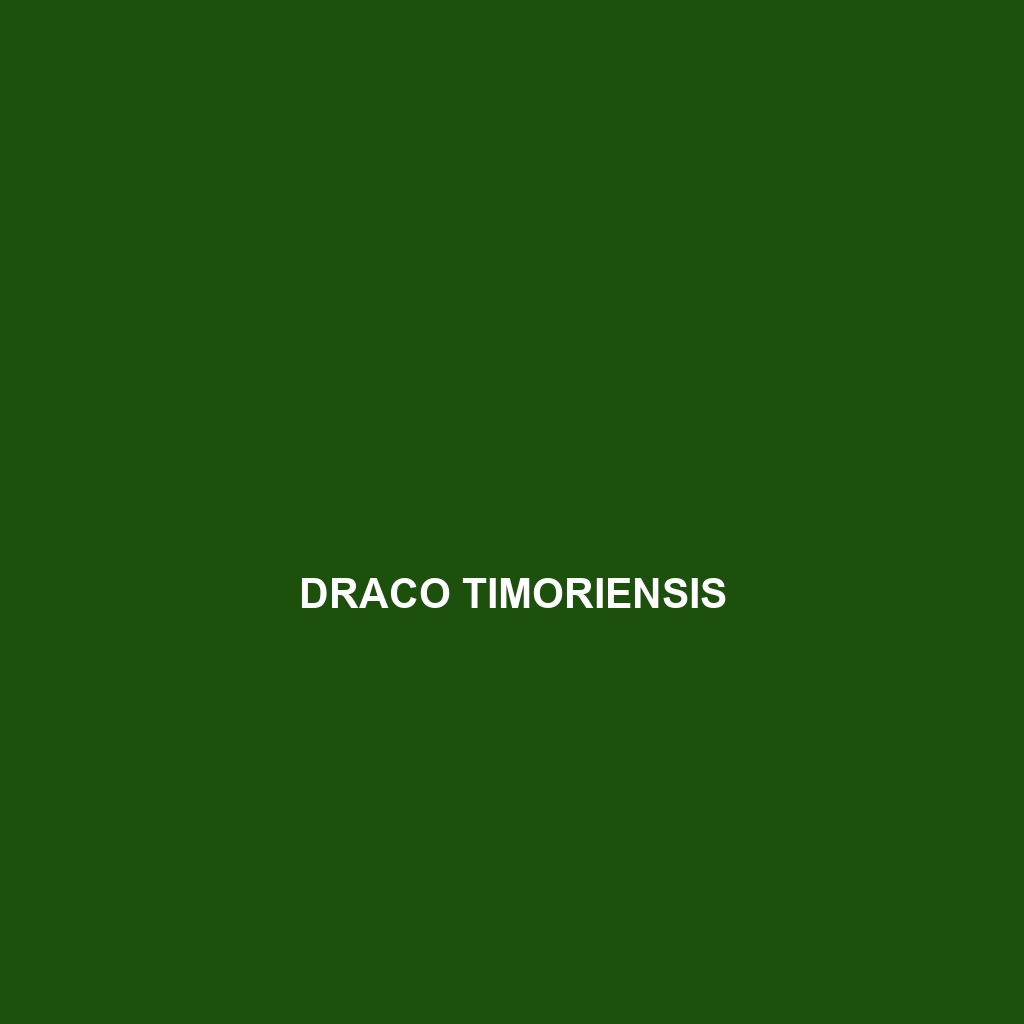Common Name
Draco timoriensis
Scientific Name
Draco timoriensis
Habitat
Draco timoriensis, commonly known as the Timor flying dragon, is primarily found in the lush rainforests of Southeast Asia, particularly on the islands of Timor and the surrounding regions. This unique species thrives in rainforests where it can easily navigate through the dense foliage. The humid climate provides favorable conditions for its survival, allowing it to interact with various plant species that support its lifestyle. Draco timoriensis is also sometimes spotted in adjacent temperate forests, where the availability of insects remains high. Additionally, this species has been observed in savanna regions during exploratory behavior, demonstrating its adaptability to different environments, although it primarily prefers forested areas.
Physical Characteristics
The Draco timoriensis is characterized by its remarkable ability to glide through the trees. Adult individuals typically reach a size of 25 to 30 centimeters in length, with a wingspan that can extend up to 60 centimeters. These lizards possess a distinctive flattened body shape, enabling them to glide efficiently from tree to tree. The coloration varies but generally includes shades of green and brown, allowing for camouflage among the foliage. One unique feature of the Timor flying dragon is its elongated ribs that support flaps of skin from its neck to its sides, which open out like wings during gliding. This physical adaptation, paired with a throat flap known as a dewlap, not only aids in gliding but also serves as a display during social interactions and mating rituals.
Behavior
Draco timoriensis exhibits fascinating behaviors, particularly its gliding ability. These reptiles are primarily arboreal and can glide distances of up to 10 meters (about 30 feet) to move between trees, which is essential for escaping predators and seeking food. They are diurnal, spending most of their daylight hours basking in the sun or foraging. Social interactions can include displays of their throat flaps during mating rituals or territorial disputes. While not migratory, they may shift locations based on food availability. Additionally, they exhibit a unique behavior where they will ‘sail’ down to lower branches to hunt for insects or retreat from threats, showcasing their adaptability and skill in navigating their environment.
Diet
The diet of Draco timoriensis primarily consists of insects, making them insectivorous creatures. Their diet includes ants, termites, and a variety of other small arthropods found in their forest habitat. Due to their gliding abilities, they can efficiently hunt for food without descending to the ground, thereby minimizing exposure to ground-based predators. Occasionally, they might consume small fruits or plant material, reflecting some **omnivorous behavior**. Their feeding habits are closely tied to their habitat, as the availability of food sources can vary with seasonal changes.
Reproduction
Reproductive activities in Draco timoriensis are typically observed during the wet season, when food is abundant, and environmental conditions are ideal. Mating rituals involve males displaying their throat flaps to attract females, engaging in elaborate displays that showcase their size and health. After mating, females lay one to two eggs in hollows or crevices within the trees, where they are relatively safe from predators. The gestation period is approximately six weeks, with hatchlings emerging fully formed and capable of gliding shortly after birth. Parental care is minimal; however, the young remain close to their nesting area until they are ready to venture out on their own.
Conservation Status
The conservation status of Draco timoriensis is classified as least concern by the IUCN Red List, thanks in part to its broad distribution and adaptable nature. However, habitat destruction due to logging and land conversion for agriculture poses significant threats to its populations. Conservation efforts are focusing on habitat preservation and establishing protected areas to ensure the sustainability of their forest environments. Continued monitoring and research are necessary to address the potential impacts of climate change and human activities on their population dynamics.
Interesting Facts
Draco timoriensis holds the title of one of the most adept gliders among reptiles, often compared to flying squirrels for its remarkable flight capabilities. Their unique morphology not only allows efficient gliding but also aids in thermoregulation, as their flattened bodies enable them to catch sunlight easily. Additionally, these reptiles have a slow metabolic rate, allowing them to conserve energy during times when food is scarce, further illustrating their adaptability as a species.
Role in Ecosystem
The ecological role of Draco timoriensis extends beyond its predatory habits. As a predator of numerous insects, it helps regulate insect populations, contributing to the overall health of its forest ecosystem. Moreover, by being part of the food chain, they serve as prey for larger birds and mammals. Their gliding behavior also plays a role in pollination and seed dispersal of certain plant species, showcasing their contribution to maintaining biodiversity within their habitat. In this way, Draco timoriensis can be seen as a keystone species that helps uphold the balance of its ecological community.
